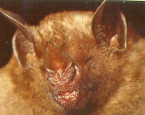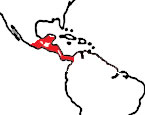|
Seba's
Short-tailed Bat
(Carollia perspicillata) |
||||
|
|
Physical
characteristics and distribution
|
|
Head
and body length of C.
perspicillata
is 48-65 mm, with a tail length of 3-14 mm and forearm length
of 35-45 mm. Weights average 10-20 grams. Coloration of C.
perspicillata is generally dark brown to rusty but 1 or
2 specimens of 50 from Central America are a clear pale orange.
|
|
Description
of the brain
|
|
Animal
source and preparation
|
|
All
specimens collected followed the same preparation
and histological procedure.
|
Other Related Resources (websites and publications)



